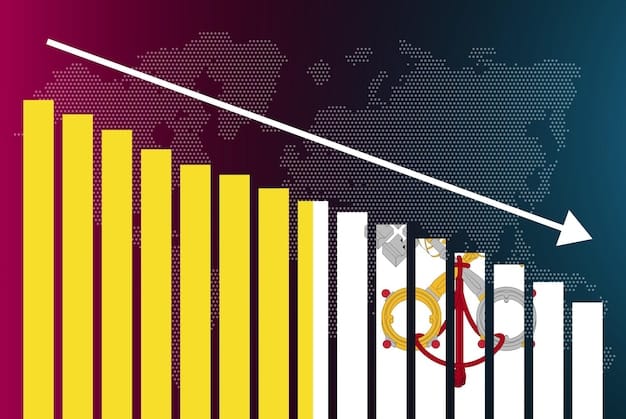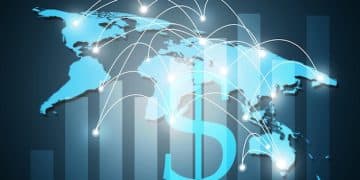2.8% GDP Growth in 2025: What It Means for US Businesses

The projected 2.8% GDP growth in 2025 signals moderate economic expansion for the U.S., potentially leading to increased consumer spending and investment opportunities for businesses, but also posing challenges around inflation and labor market adjustments.
The anticipation surrounding economic forecasts is always palpable, and the projected 2.8% GDP growth for the US in 2025 is no exception. But what does this number really mean for American businesses? Let’s dive into the specifics and unpack the potential impacts of this growth forecast.
Understanding GDP and Its Significance
Gross Domestic Product (GDP) is a fundamental measure of a country’s economic health. It represents the total value of goods and services produced within a nation’s borders over a specific period, typically a quarter or a year. Understanding GDP is crucial for businesses as it provides insights into the overall demand, investment climate, and potential growth opportunities within the economy.
A growing GDP generally signifies a healthy economy, characterized by increased production, higher employment rates, and greater consumer spending. Conversely, a declining GDP can indicate an economic slowdown, potentially leading to business contraction and job losses. What Does the Projected 2.8% GDP Growth Mean for US Businesses in 2025? Well, it suggests a moderate expansion, but the devil is in the details.
Components of GDP
GDP is calculated by summing up several key components:
- Consumer spending: The largest component, reflecting household purchases of goods and services.
- Investment: Business spending on capital goods like equipment and structures, as well as changes in inventory.
- Government spending: Expenditures by federal, state, and local governments on goods and services.
- Net exports: The difference between a country’s exports and imports.
The interplay of these components determines the overall GDP growth rate. Changes in consumer confidence, business investment decisions, government policies, and global trade dynamics all influence these components and, consequently, the GDP.
Understanding the components of GDP and how they interact is vital for businesses to make informed decisions, anticipate market trends, and strategically position themselves for success in the evolving economic landscape.
In short, GDP serves as a vital barometer of economic health, providing businesses with essential information to navigate the complexities of the market and make strategic choices that align with the prevailing economic conditions.

Impact on Various Sectors
A 2.8% GDP growth won’t impact all sectors equally. Some will thrive, while others might face challenges adapting to the changing economic landscape. Predicting these impacts is a keen strategy for businesses.
Sectors heavily reliant on consumer spending, such as retail and hospitality, could see a boost as increased economic activity typically leads to higher disposable incomes and greater consumer confidence. On the other hand, sectors facing global competition or reliant on exports might experience slower growth due to trade dynamics and international economic conditions.
Winners and Losers
Let’s look at potential winners and losers:
- Technology: Innovation and adoption will continue, driving growth.
- Healthcare: A growing population and aging demographics ensure steady demand.
- Construction: Infrastructure projects and housing demand could provide a lift.
- Manufacturing: Subject to global competition and trade policies, growth might be tempered.
Businesses need to carefully assess their sector’s outlook in light of the projected GDP growth and adjust their strategies accordingly. For example, retailers might want to increase inventory to meet anticipated demand, while manufacturers might consider diversifying their export markets.
By understanding the unique dynamics of their respective sectors, businesses can make informed decisions and navigate the complexities of the projected 2.8% GDP growth in 2025. Vigilance and proactive planning are key to capitalizing on opportunities and mitigating potential challenges.
Opportunities for Business Expansion
A growing economy typically presents numerous opportunities for businesses to expand their operations. This includes increased investment, innovation, and new market ventures. The projected 2.8% GDP growth in 2025 could unlock a variety of avenues for businesses seeking to grow and diversify.
As consumer spending increases, businesses can explore expanding their product lines, entering new geographic markets, or investing in marketing and advertising campaigns to reach a wider audience. Increased investment activity can also lead to opportunities for businesses specializing in capital goods, construction, and related services.
Strategies for Growth
Consider these strategies:
- Evaluate potential new markets and customer segments.
- Invest in research and development to innovate and differentiate products.
- Explore strategic partnerships and acquisitions to expand market reach.
- Enhance operational efficiency to improve profitability and competitiveness.
Businesses should also closely monitor consumer preferences and market trends to identify emerging opportunities and tailor their expansion strategies accordingly. Adapting to changing consumer behavior, embracing digital technologies, and focusing on customer experience will be crucial for success in a growing economy.
By carefully evaluating the opportunities presented by the projected GDP growth and implementing strategic expansion plans, businesses can position themselves for long-term success and capitalize on the positive economic climate in 2025.

Potential Challenges and Risks
Economic growth isn’t without its potential downsides. Inflation, labor shortages, and increased competition are among the challenges businesses might face with a 2.8% GDP growth.
Rising consumer demand and increased production can lead to inflationary pressures, eroding profit margins and potentially impacting consumer spending. Labor shortages, particularly in skilled trades and specialized industries, can also constrain business operations and drive up labor costs. Increased competition from both domestic and international players can intensify as businesses seek to capitalize on growth opportunities.
Mitigating the Risks
Businesses can take several steps to mitigate these risks:
Implement cost-control measures to manage inflationary pressures. Invest in employee training and development to address labor shortages. Differentiate products and services to stand out in a competitive market.
Businesses should also proactively monitor economic indicators, such as inflation rates, unemployment figures, and consumer confidence indexes, to anticipate potential challenges and adjust their strategies accordingly. Building resilience and agility into business operations will be crucial for navigating potential risks and maintaining profitability in a growing economy.
Businesses must be prepared for potential pitfalls. Careful planning and risk management are crucial to ensuring sustainable growth and profitability amidst potential challenges.
Government Policies and Regulations
Government policies and regulations play a significant role in shaping the business environment and influencing economic growth. Fiscal policies, monetary policies, and regulatory frameworks can all have a direct impact on business operations, investment decisions, and overall economic performance. An analysis of these actions is invaluable for business planning.
Fiscal policies, such as tax cuts or increased government spending, can stimulate economic activity and boost GDP growth. Monetary policies, such as interest rate adjustments, can influence borrowing costs, investment levels, and inflation. Regulatory frameworks, such as environmental regulations or labor laws, can impact business costs, operating procedures, and competitive dynamics.
Policy Watch
Keep an eye on:
- Tax reforms: Potential changes to corporate tax rates or tax incentives for investment.
- Infrastructure spending: Government investments in transportation, energy, and communication networks.
- Trade policies: Trade agreements, tariffs, and trade regulations affecting international trade.
- Regulatory changes: Environmental regulations, labor laws, and industry-specific regulations.
Businesses should closely monitor government policies and regulations to anticipate potential changes and adapt their strategies accordingly. Engaging with policymakers, participating in industry associations, and staying informed about regulatory developments can help businesses navigate the evolving political and regulatory landscape.
By understanding the impact of government policies and regulations, businesses can make informed decisions, mitigate potential risks, and capitalize on opportunities arising from the changing political and regulatory environment.
Strategic Planning for 2025
Given the projected 2.8% GDP growth, strategic planning is crucial for businesses aiming to thrive in 2025. This involves assessing market dynamics, identifying growth opportunities, and developing strategies to navigate potential challenges.
Businesses should conduct a thorough analysis of their industry, target market, and competitive landscape to identify key trends and opportunities. Developing flexible and adaptable business plans, investing in innovation and technology, and fostering a culture of continuous improvement will be essential for staying ahead in a dynamic economic environment.
Key Considerations
Here are some suggestions:
- Market Research: Stay informed about consumer preferences, market trends, and emerging technologies.
- Financial Planning: Develop robust financial models and risk management strategies.
- Operational Efficiency: Streamline processes, reduce costs, and improve productivity.
- Talent Management: Attract, retain, and develop skilled employees to drive innovation and growth.
Effective strategic planning requires a forward-looking perspective, a willingness to adapt to changing conditions, and a commitment to continuous learning and improvement. Businesses that embrace strategic planning and proactively adapt to the evolving economic landscape will be well-positioned for success in 2025 and beyond.
In summary, solidifying plans now is paramount. Anticipate shifts and prepare to leverage the positive aspects while navigating potential hurdles.
| Key Aspect | Brief Description |
|---|---|
| 📈 GDP Growth | 2.8% growth suggests moderate economic expansion. |
| 🏢 Sector Impacts | Retail, tech, and healthcare sectors may benefit most. |
| ⚠️ Key Challenges | Inflation, labor shortages, and competition are risks. |
| 🏛️ Gov Policies | Fiscal, monetary & regulatory actions affect business. |
Frequently Asked Questions
▼
A 2.8% GDP growth rate suggests a moderate expansion of the US economy. It signifies an increase in the production of goods and services, leading to potential business opportunities.
▼
Sectors like technology, healthcare, and retail are poised to benefit most from the GDP growth due to increased consumer spending and investment in these areas.
▼
Potential risks include inflation, labor shortages, and increased competition. These factors could impact operating costs and profitability if not managed effectively.
▼
Government policies, such as tax adjustments and regulations, can influence investment decisions and operational strategies. Staying informed of policy changes is crucial for adapting in time.
▼
Focus on market research, operational efficiency, and financial planning. Being proactive allows you to handle upcoming opportunities while navigating potential pitfalls well prepared.
Conclusion
The projected 2.8% GDP growth for US businesses in 2025 presents a landscape of both opportunity and challenge. While a growing economy can spur innovation, expansion, and increased profits, businesses must also be prepared to navigate potential risks such as inflation, labor shortages, and increased competition. By understanding these dynamics, closely monitoring government policies, and engaging in strategic planning, businesses can position themselves to capitalize on the positive economic climate and achieve sustainable success.





